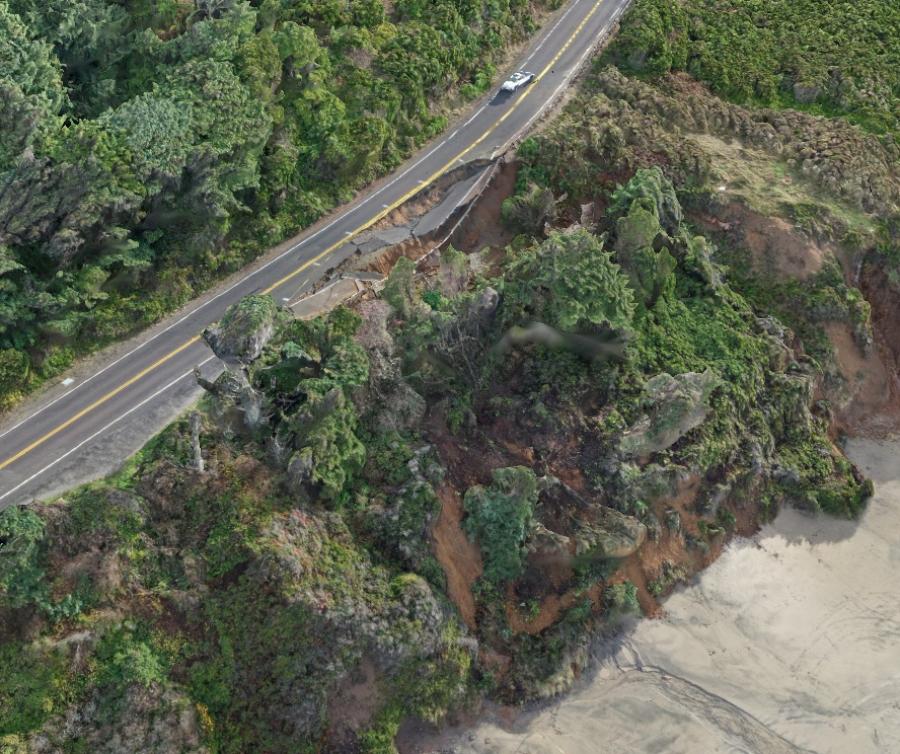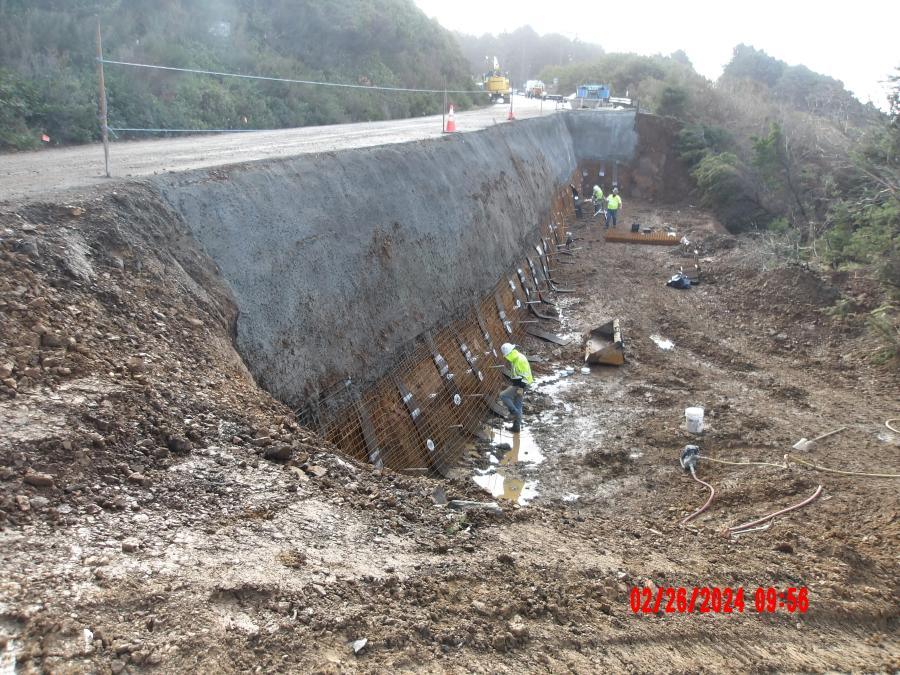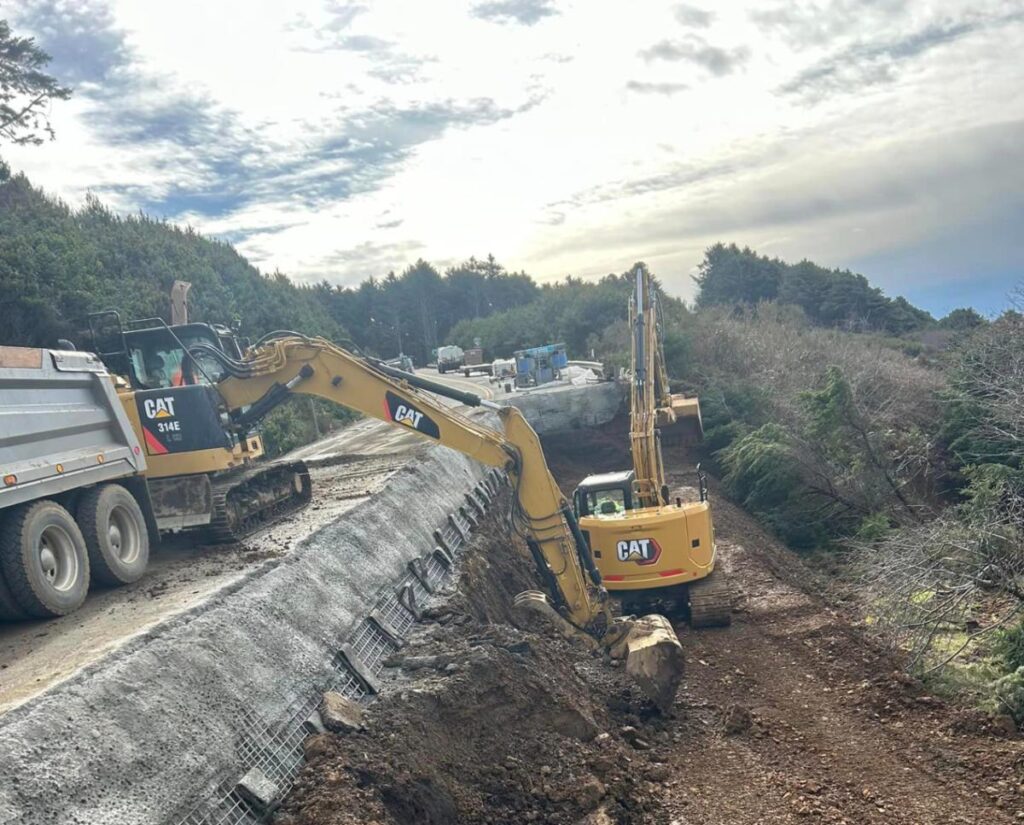Photo courtesy of Advanced Excavation
Officials are contemplating the best solution after a 175-ft. section of road in Tillamook, Ore., connecting the destination town of Pacific City and residential village north of Tierra Del Mar, slipped from the headlands.
Four months after heavy Oregon rains washed out a coastal road, Sandlake Road is open to one lane and engineers are considering the best of two permanent repairs. A 175-ft. section of road connecting the destination town of Pacific City and residential village north of Tierra Del Mar slipped from the headlands the first week of December.

Photo courtesy of ODOT
“There was just a lot of ground saturation and the hillside just collapsed on itself,” said Chris Laity, Tillamook County public works director. “There was stack of soil and that was on top of sandstone, so it had a hard layer. As the water would seep its way down through the soil, it would hit sandstone. The water sliding across it caused a slip plane and that caused the road to fail.”
While the road is not heavily traveled, it is the route residents in Tierra Del Mar take to do business in Pacific City, including picking up mail at the United States Post Office. While one lane remained intact, Laity and experts didn’t trust it to hold, so they barricaded off the existing lane. That meant a normally 10-min. drive from Tierra Del Mar to Pacific City suddenly became one of 45 minutes and that grew old fast. So, some took matters in their own hands.
“People moved barricades,” Laity said. “They cut chains, cut the cables. It was a little bit of a fight on that one.”
By February, Geostabilization International, headquartered in Colorado, moved in with specialized equipment to build a soil nail wall. Advanced Excavation, based out of Garibaldi, Ore., is serving as the general contractor.
“You have rods that are drilled into the soil, about 30 feet in and they’re about one inch in diameter,” Laity said. “There’s about 200 of them and once they are drilled into the soil, there’s a thick welded wire mesh that goes over the top of the nails and then it’s basically a ginormous washer with a bolt that is screwed onto the nails. You’ve got the wire mesh and all the nails supporting the weight of the soil and then it’s all shotcrete. They spray concrete on it and that seals up everything from corrosion.”
Now that one lane of Sandlake Road is open to traffic, Laity and county and state officials must decide on the best permanent repair.
One option is the placement of a mechanically stabilized vertical wall, while the other is a slope. Both involve the layering of geogrid and soil and both are considered stable and good options, but there are differences, Laity said.
“The technology is pretty much the same,” she said. “But the base of the wall, because it’s vertical, there are some additional things that must be done to keep that vertical. So, the difference between the two is a wall is built in 100 percent of the right-of-way. The slope would go beyond the county right-of-way into state park’s property.”

Photo courtesy of ODOT
Because the slope would encroach on state parks land, for which the state has received federal funding, it would involve state and federal government approval. Another difference is the cost — approximately $1 million. The wall could be built at a cost of about $2.8 million, while the cost of the slope is estimated to be about $1.8 million. The wall comes at a higher cost because construction methods are more complicated, more equipment is needed and it’s more challenging and time-consuming to build, Laity said.
“I think everybody all across the board would say the slope is better,” she said. “They’re both stable, but long term when you start going out 70 years … walls are susceptible to failure where with the slope, there is not much there to fail. With a slope, you take a bulldozer out there and spread all kinds of materials. Another layer of grid, 12 more inches of material … What that does is the grid lets the rocks interlock together. The whole thing, basically, becomes a homogenous material, it’s all interlocked. It’s just going to be a better solution, more natural. You can plant on a slope; you can’t plant on a wall and its better aesthetics from the beach and that’s important to people.”
Laity hopes to see the final repair in place sometime in 2025. CEG
Read the full article here











